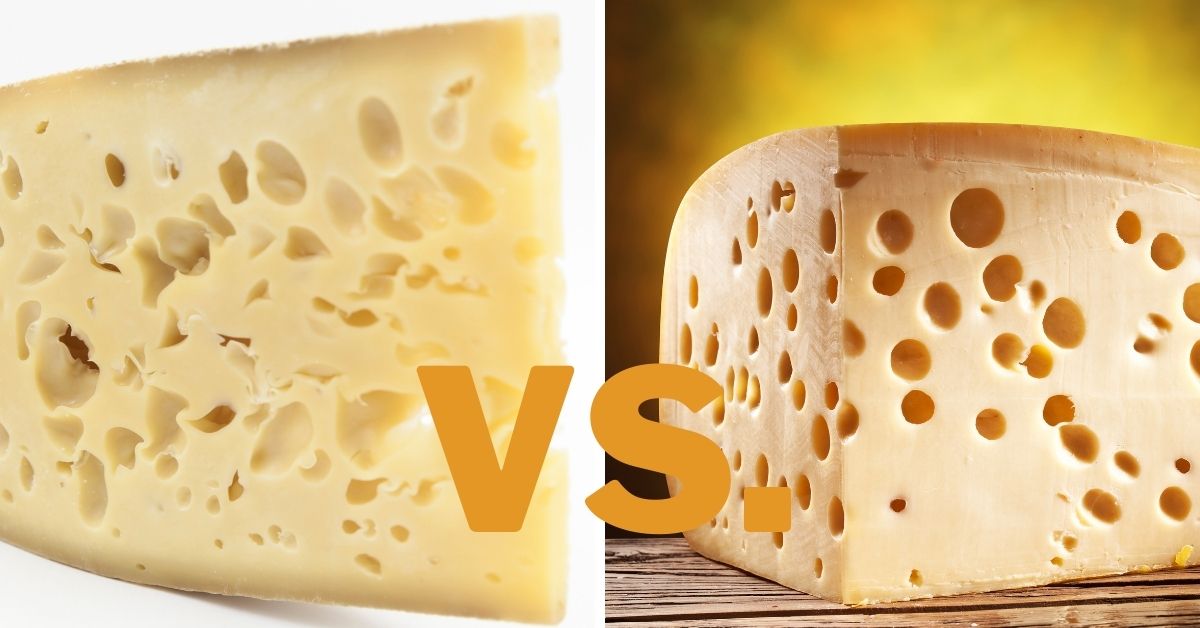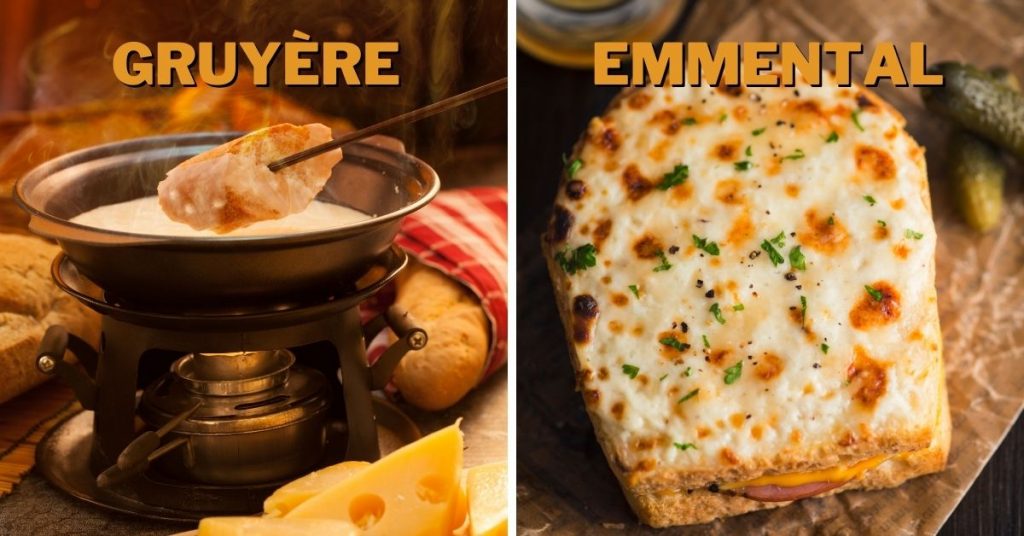Gruyère vs. Emmental: Differences & Which Is Better?

Emmental and Gruyère are two of the most well-known Swiss cheeses, both of which are highly prized in fondue for their flavor and melting ability. However, despite their widespread popularity, many people seem to have trouble getting the two types of cheese apart.
Emmental cheese has a much milder flavor than Gruyère, but they can be used as substitutes in many recipes. Emmental features big holes associated with Swiss cheese in popular culture, while Gruyère has smaller holes. In addition, Gruyère is more fattening and saltier than Emmental, and it is perfect for creamy fondue.
Continue reading this article to find out more about the background of both kinds of cheese and a detailed comparison of their characteristics.
What Is Emmental?
Emmental is a semi-hard, partially skimmed cow’s milk cheese from Switzerland, which is distinguished by large, walnut-sized holes created throughout the fermentation process. The manufacturing of Emmental can be traced back to the 13th century in the Emme Valley in the Swiss region of Bern. It is regarded as the oldest and most prestigious cheese in Switzerland and is considered to be an important part of Swiss culture.
According to the maturation process, the so-called aging, Emmentaler is divided into several types – “Classic,” which matures in four months, “Reserve,” which matures in eight months, and “Premier Cru,” which takes 14 months to mature.
Depending on how long it has aged, the taste of this pale yellow cheese can range from mild and buttery to fruity and full-flavored.
It has excellent melting qualities, so it is typically used to make cheese fondue and other melted-cheese dishes, such as gratins and casseroles, grilled cheese sandwiches, and pasta.
What Is Gruyère?
Gruyère is a hard cow-milk cheese that comes from the same-named valley in Fribourg, Switzerland, and it’s noted for its rich, creamy, salty, and nutty flavor.
Because its flavor is nice but not overpowering, Gruyère is ideal for baking. Since it melts well, it’s also great for fondues and dips. Moreover, it gives cheese-infused comfort meals like quiches and gratins a particularly creamy texture and a faint sweetness.
To manufacture Gruyère, raw cow’s milk is heated to 34 degrees Celsius in a copper vat, then curdled with liquid rennet, separating the curds from the whey. The curds are placed in molds, brine-salted, and smeared with bacteria.
The cheese is then ripened at room temperature for at least two months, usually on wooden boards. It is turned every few days to achieve even moisture distribution. It can be aged for up to ten months before developing a more intense, almost earthy flavor.
Gruyère can be aged from 8 to even 18 months, with longer aging yielding a more flavorful cheese. It’s important to mention that while young cheese has a distinct creaminess and nuttiness, mature Gruyère has developed a more complex, earthy flavor.
Gruyère vs. Emmental: Differences
Let’s see how to differentiate between Gruyére and Emmental in detail.
Appearance
One of the key differences between these types of cheese is their visual appearance. Even though both products are pale yellow in color, Emmentaler is characterized by huge holes created by pockets of gas during a fermenting process that lasts three to six months.
On the other hand, Gruyére has fewer holes, which are also smaller and more evenly spaced than in Emmental. You shouldn’t be surprised even if the holes shrink to almost indiscernible sizes during the aging process.
Gruyère comes in smaller wheels than Emmental, weighing between 30 and 40 kilograms, and has a more pronounced flavor than its larger counterpart thanks to the longer aging time
Emmental can be stored for up to six weeks in the refrigerator and frozen for up to three months with little change in flavor or texture. If tightly wrapped and refrigerated, Gruyere can also last for several weeks.
Taste and Melting
Both kinds of cheese are quite similar when it comes to origin, use, and storing properties. But, when it comes to taste, Gruyère is a bit more fattening and saltier than Emmental, and arguably a tad more flavorful.
Both kinds of cheese come from Switzerland, albeit in two different regions, and are particularly suited for fondues and cheese dishes due to their distinctive melting properties. But, traditionally, Gruyère is used for the creamiest fondue.

Nutrition Facts
With 49 to 53% milk fat in dry matter, or 23% milkfat per 1 kg of cheese, Gruyère belongs to the category of full-fat cheeses. Extremely rich in potassium, proteins, magnesium, and vitamins A, B6, B12, and D, Gruyère is a real nutritional bomb, with 100g of cheese containing approximately 413 calories. [1]
Emmentaler is also rich in potassium and sodium, proteins, fats, water, vitamins A, E, B6, B12, and K, but slightly less caloric, with 100g of cheese amounting to 380 calories. Having in mind that it takes almost 800 liters of milk to make a wheel of Emmental, it’s safe to say this cheese is abundant in calcium. [2]
Gruyère vs. Emmental: Which Is Better?
Choosing between these two delicious kinds of cheese can be a really hard task, and it has a lot to do with your preferences, the amount you are willing to spend, and the shops in your vicinity.
That being said, Emmental is available in well-stocked supermarkets or specialty stores, with prices ranging from moderate to expensive. Gruyère is slightly scarcer and pricier. In the US, it can cost anywhere from $14 to $18 per pound, which is a significant sum to spend if you only want to grab a bit of Gruyère for a single recipe.
Even though Emmental is more than an adequate substitute, Gruyère is an ideal cheese to use when the recipe’s end result needs to be nice and creamy, so sometimes splurging a bit pays off.
However, in the end, no matter which type of cheese you choose, it’s certain that your guests will be impressed by any souffle, croquet monsieur, or traditional French onion soup containing these famous delicacies. So, sit back, pour yourself a glass of high-quality wine, and treat your palates to a real feast!
